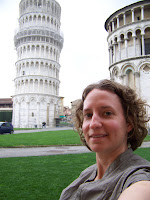
A short 1/2 hour train ride to the west of Firenze lands you in Pisa. A 25 minute walk from the train station gets you into the old part of town. Pisa was a long ago booming metropolis. Then a port town on the Mediterranean, it flourished with art, science and culture. The diversity of people included Africa, France, along with areas of western Asia. Galileo Galilei prospered here among many other brilliant people. After pummelings from various neighboring powers, Pisa declined and fell more toward the strong Medici influence of Firenze. Most notably we recognize the town for its famous campanile that is leaning south at a precarious angle. Upon reaching the Campo dei Miracoli (Field of Miracles), my first reaction was "I thought the tower would be taller." In pictures the tower looks to be 7-8 stories high. Standing there in person it seemed more like 5 stories.
My first goal was to secure a ticket for climbing the leaning tower just in case it turned out to be a busy day and the time slots were all filled. I managed to get the last spot for the 12:40pm climb. Apparently there was plenty of space, but I'm glad I started with the tower and then had the rest of the time slowly view the other areas. The climb to the top is 300 steps (though I only counted 295) spiraling around the inside to about the 6th floor and then spiraling in a smaller staircase on the north side up to the very top floor. The marble steps are deeply worn at varying angles as you feel the angle of the tower in the circular climb.

It looked to be about a good 1/2" depression in the stone. How long and how many people has it taken to make that kind of dent in marble?? When you finally reach the top, the view is fantastic and much higher than it looks from the ground. The height of the people on the ground looked to be about the size of my thumb.

Next door to the leaning tower is the duomo (cathedral) with the typical decorative ceiling, massive paintings in side chapels and ornate main altar. The raised pulpit was designed by Nicola Pisano and was it every large. The platform was roughly 6ft. in diameter. Imagine delivering a sermon from there! Behind the duomo is the baptistry. This circular building was designed after the one in Jerusalem. The most interesting feature is the acoustics.

Every half hour a woman sings a demonstration of the sound quality. By singing in a normal voice from the center, her voice filled the entire room (floor to ceiling) as she created beautiful chords with minimal effort. To the side of the baptistry is the Camposanto. This was probably the least interesting building as it is a cemetery filled with local Pisan civic, cultural and spiritual leaders. The frescoes were nice, but they really aren't my flavor of art.
 The initial sketches done in a red earthen mixture prior to the fresh (fresco) plaster layer were discovered when the frescoes peeled off from decay. These sketches are now preserved in a museum near the duomo. It was really stunning to see the plans laid out by these master artists and how they occasionally shifted a pose. My last stop was a more general museum housing various bits of art and history from the duomo, campanile and Camposanto.
The initial sketches done in a red earthen mixture prior to the fresh (fresco) plaster layer were discovered when the frescoes peeled off from decay. These sketches are now preserved in a museum near the duomo. It was really stunning to see the plans laid out by these master artists and how they occasionally shifted a pose. My last stop was a more general museum housing various bits of art and history from the duomo, campanile and Camposanto.Another quick 30 minute train ride brought me back to Firenze. Dinner was left overs again as I needed to finish off my food before moving on to my next stop. I'm planning on heading to Cinque Terre--a national park area with 5 resort villages along the western Mediterranean cost of Italy known as the Ligurian Sea or the Gulf of Genova.

No comments:
Post a Comment